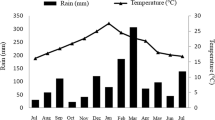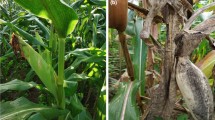Summary
Variation in susceptibility to the safe broad-spectrum herbicide glyphosate was investigated in maize. Eleven inbred lines, grown in a growth chamber, were evaluated for their tolerance to the herbicide at 2.4 mM (0.2 kg a.i. in 400 I ha-1 of water). Following treatment with glyphosate at the three-leaf stage, significant variation in damage, expressed as visual injury ratings scored 7, 14 and 21 days after the application of the herbicide, was found. Effects on dry weight and shoot height were consistent with visual scores and the carbon-exchange rate was found to be a sensitive index of differential injury.
Biochemical characterization of 5-enol-pyruvyl-shikimate-3-phosphate (EPSP) synthase, the main target of the herbicide, ruled out the possibility that this differential susceptibility was due to variations in the sensitivity of the enzyme. On the contrary, a positive correlation was found between in vivo tolerance and EPSP synthase levels, measured at different stages during seedling growth. This result suggests that a naturally occurring difference in EPSP synthase levels in the tissues may contribute to the differential response observed in vivo in maize inbreds.
Similar content being viewed by others
Abbreviations
- CER:
-
carbon-exchange rate
- EPSP:
-
5-enol-pyruvyl-shikimate-3-phosphate
- ID50 :
-
concentration causing 50% inhibition
References
Bradford, M.M., 1976. A rapid and sensitive method for the quantiation of microgram quantities of protein utilizing the principle of protein-dye binding. Anal. Biochem. 72: 248–254.
Coggins, J.R., M.R.Boocock, S.Chauduri, J.M.L.Lambert, J.Lumsden, G.A.Nimmo & D.D.S.Smith, 1987. The arom multifunctional enzyme from Neurospora crassa. Methods in Enzymology 142: 325–338.
Cole, D.J., 1985. Mode of action of glyphosate-a literature analysis. In: E.Grossbard & D.Atkinson (Eds.), The herbicide glyphosate, pp. 48–74, Butterworths, London.
Comai, L., D.Facciotti, W.R.Hiatt, G.Thompson, R.E.Rose & D.M.Stalker, 1985. Expression in plants of a mutant aroA gene from Salmonella typhimurium confers tolerance to glyphosate. Nature 317: 741–744.
Comai, L., L.C.Sen & D.M.Stalker, 1983. An altered aroA gene product confers resistance to the herbicide glyphosate. Science 221: 370–371.
della-Cioppa, G., S.C.Bauer, M.L.Taylor, D.E.Rochester, B.K.Klein, D.M.Shah, R.T.Fraley & G.M.Kishore, 1987. Targeting a herbicide-resistant enzyme from Escherichia coli to chloroplasts of higher plants. Bio/technology 5: 579–584.
Donn, G., E.Tischer, J.A.Smith & H.M.Goodman, 1984. Herbicideresistant alfalfa cells: an exemple of gene amplification in plants. J. Mol. Appl. Genet. 2: 621–635.
Duncan, C. & S.C.Weller, 1987. Heritability of glyphosate susceptibility among biotypes of field bindweed. J. Heredity 78: 257–260.
Eberlein, C.V., K.M.Rosow, J.L.Geadelmann & S.J.Openshaw, 1989. Differential tolerance of corn genotypes to DPX-M6316. Weed Sci. 37: 651–657.
Einot, I. & K.R.Gabriel, 1975. A study of the powers of several methods of multiple comparisons. J. Am. Stat. Ass. 70: 351–355.
Forlani, G., E.Nielsen, P.Landi & R.Tuberosa, 1991. Chlorsulfuron tolerance and acetolactate synthase activity in corn (Zea mays L.) inbred lines. Weed Sci. 39: 553–557.
Forlani, G., E.Nielsen & M.L.Racchi, 1992. A glyphosateresistant 5-enol-pyruvyl-shikimate-3-phosphate synthase confers tolerance to a maize cell line. Plant Sci. 85: 9–15.
Goldsbrought, P.B., E.M.Hatch, B.Huang, W.G.Kosinsky, W.E.Dyer, K.M.Herrmann & S.C.Weller, 1990. Gene amplification in glyphosate tolerant tobacco cells. Plant Sci. 72: 53–62.
Harms, C.T., A.L.Montoya, L.S.Privalle & R.W.Briggs, 1990. Genetic and biochemical characterization of corn inbred lines tolerant to the sulfonylurea herbicide primisulfuron. Theor. Appl. Genet. 80: 353–358.
Kishore, G.M., L.Brundage, K.Kolk, S.R.Padgette, D.Rochester, K.Huyn & G.della-Cioppa, 1986. Isolation, purification and characterization of a glyphosate tolerant mutant E. coli EPSP synthase. Fed. Proc. 45: 1506.
Landi, P., A.Vicari & P.Catizone, 1989. Response of maize (Zea mays L.) inbred lines and hybrids to chlorsulfuron. Weed Res. 29: 265–271.
Landi, P., E.Frascaroli & P.Catizone, 1990. Variation and inheritance of response to acetochlor among maize inbred lines and hybrids. Euphytica 45: 131–137.
Moore, S., 1968. Aminoacid analysis: aqueous dimetyl sulphoxyde as solvent for the ninhydrin reaction. J. Biol. Chem. 243: 6281–6283.
Racchi, M.L., 1990. Glyphosate tolerance in plant cell cultures. In: R.S.Sangwan & B.S.Sangwan-Norreel (Eds.), The impact of biotechnology in agriculture, pp. 437–446, Kluwer Academic Press, the Netherlands.
Rubin, J.L., C.G.Gaines & R.A.Jensen, 1984. Glyphosate inhibition of 5-enolpyruvylshikimate 3-phosphate synthase from suspension-cultured cells of Nicotiana silvestris. Plant Physiol. 75: 839–845.
Sebastian, S.A. & R.S.Chaleff, 1987. Soybean mutants with increased tolerance for sulfonylurea herbicides. Crop Sci. 27: 948–952.
Sellin, C., G.Forlani, J.Dubois, E.Nielsen & J.Vasseur, 1992. Glyphosate tolerance in Cichorium intybus L. var. Magdebourg. Plant Sci. 85: 223–231.
Shultz, A., D.Sost & N.Amrhein, 1984. Insensitivity of 5-enolpyruvylshikimic acid-3-phosphate synthase confers resistance to this herbicide in strain of Aerobacter aerogenes. Arch. Microbiol. 137: 121–123.
Snedecor, G.W. & W.G.Cochran, 1967. In: Statistical methods, Sixth Edition, pp. 159–160. The Iowa State University Press, Ames, Iowa.
Stall, W.M. & T.A.Bewick, 1992. Wweet corn cultivars respond differentially to the herbicide nicosulfuron. Hort Sci. 27: 131–133.
Steinrücken, H.C. & N.Amrhein, 1980. The herbicide glyphosate is a potent inhibitor of 5-enolpyruvyl-shikimic acid-3-phosphate synthase. Biochem. Biophys. Res. Commun. 94: 1207–1212.
Steinrücken, H.C., A.Schultz, N.Amrhein, K.A.Porter & R.T.Fraley, 1986. Overproduction of 5-enolpyruvyl-shikimate-3-phosphate synthase in a glyphosate-tolerant Petunia hybrida cell line. Arch. Biochem. Biophys. 244: 169–178.
Torstennson, L., 1985. Behaviour of glyphosate in soils and its degradation. In: E.Grossbard & D.Atkinson (Eds.), The herbicide glyphosate, pp. 137–150, Butterworths, London.
Turner, D.J., 1985. Effects on glyphosate performance of formulation, additives and mixing with other herbicides. In: E.Grossbard & D.Atkinson (Eds.), The herbicide glyphosate, pp. 221–240, Butterworths, London.
Author information
Authors and Affiliations
Rights and permissions
About this article
Cite this article
Forlani, G., Racchi, M.L. Glyphosate tolerance in maize (Zea mays L.). 1. Differential response among inbred lines. Euphytica 82, 157–164 (1995). https://doi.org/10.1007/BF00027062
Received:
Accepted:
Issue Date:
DOI: https://doi.org/10.1007/BF00027062




